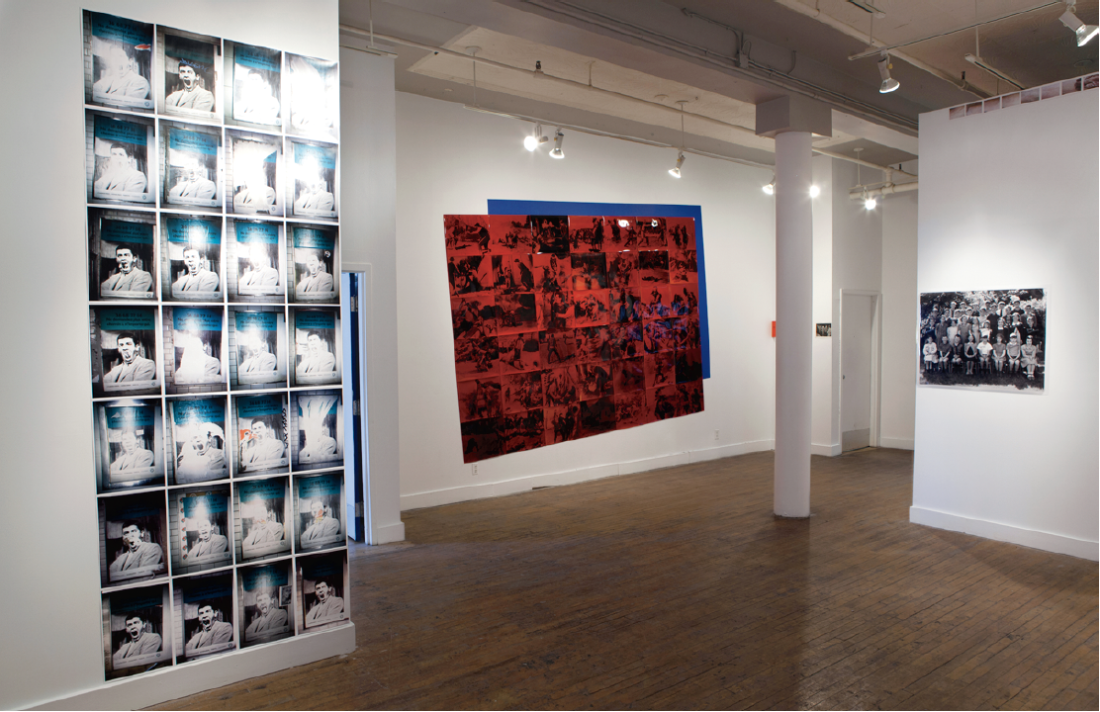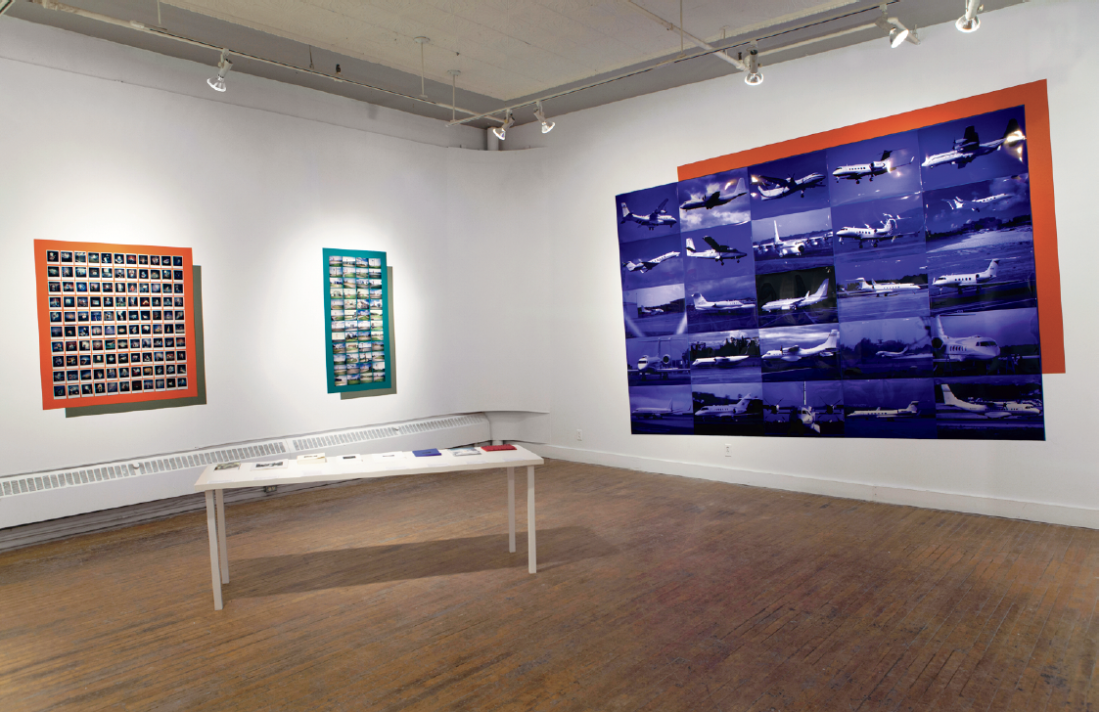Garry Neill Kennedy
Immediately following his public talk with gallery director J J Kegan McFadden at PLATFORM centre for photographic + digital arts in Winnipeg, artist Garry Neill Kennedy re-enacted a 1970 performance piece, mentally recalling the names of classmates as he wrote them over their images in the reproduction of his fourth grade class picture from 1946. At the risk of making a banal comparison, I was struck with recalling a scene in the film When Harry Met Sally, by the late writer Nora Ephron. Channelling Woody Allen, Billy Crystal’s character waxes about the song “Auld Lang Syne:”
Harry: “What does this song mean? My whole life, I don’t know what this song means. I mean, ‘Should old acquaintance be forgot?’ Does that mean that we should forget old acquaintances, or does it mean if we happened to forget them, we should remember them, which is not possible because we already forgot?”
Sally: “Well, maybe it just means that we should remember that we forgot them or something. Anyway, it’s about old friends.”
Why would I include this reference within a review of what is an important exhibition of work by a highly venerated Canadian artist? I suspect that Kennedy wouldn’t object. Conceptually, for Kennedy, the entry point to the work is always the everyday, what is revealed in the ordinariness of the everyday and how are power forces, dynamics and, increasingly, abuses made evident?

“Garry Neill Kennedy: Photoworks, 1969–2011,” installation view, PLATFORM centre for photographic + digital arts, Winnipeg. Photographs: Karen Asher.
A list of some of Kennedy’s everyday items seems common enough and includes old Hollywood cowboys and Indians movie stills, commercially available paint colours selected for their names, seemingly innocuous images of airplanes taken by amateur photographers sourced from the internet, an old fourth-grade class photo, a gathering of potted plants and a line of small digital close-ups taken of the artist’s body.
Dominating the exhibition at PLATFORM are the two works, Spotted from 2009 and Moving Stills from 1991. Moving Stills, a collection of 60 black and white film stills, enlarged, printed in red and placed in a grid, is sourced from old Hollywood cowboys and Indians movies and resonates within the city of Winnipeg, its imagery reflecting stereotypes of the ‘scary’ Indian. Its keystone though, Movie Still Photograph, 1998, is located just a few feet to the right. In it, white actors—the cowboys—brush the war paint onto the ones playing the Indians, revealing the real power dynamics within the subjugation of the other.
This re-entry into the domain of a previous work through a new one is part of Kennedy’s method. Spotted might be a seemingly innocent gathering of airplane images were you not to look back at an earlier work, The Colours of Citizen Arar, painted directly on the walls of Zwicker’s Gallery in Halifax for nine months in 2007–08. Colour choices all came from Maher Arar’s testimony in his federal commission inquiry. Black related to the hose that he was beaten with, orange to the jumpsuit he was made to wear, blue, red and yellow to the colours his body turned with beatings. In Spotted, we only have the blue of the photographs and red from its painted border. But Kennedy wants to create a dialogue through his art, the artwork being completed through the viewer’s participation. If we dig, we’ll find that all 25 dark blue images were found online and taken by plane spotters at airports around the world. Plane spotters are amateur photographers (think trainspotters) who enjoy the hobby of hanging out near airports taking photos of airplanes approaching and leaving, identifying, cataloguing and photographing their subject. The plane’s ID numbers have been made available through human rights groups such as Amnesty International. The planes were all used by the CIA “for extraordinary rendition.” Essentially, they are all what Kennedy calls torture taxis, and one of them once carried Maher Arar.

“Garry Neill Kennedy: Photoworks, 1969–2011,” installation view, PLATFORM centre for photographic + digital arts, Winnipeg.
A critical direction employed in approaching artwork such as Kennedy’s, which delves into abuses of power, is through Michel Foucault. It was Foucault who wrote on the archaeological approach to history and what could be deduced when torture by the state became hidden, as opposed to enacted within the public sphere. In The Political Philosophy of Michel Foucault (Routledge, 2008), British professor Mark Kelly writes of “Foucault seeing intellectuals as obligated to resist power.” Kennedy’s work, it seems, would include the artist. He is, he admits, becoming more bluntly political with age.
Three photographs in the exhibition, The Middle East (and Beyond), 1996–2011, The American History Painting, 1991–2011, and The Native, 1996–2011, are details of these three paintings by Kennedy. Each photo is a blow-up cross-section from a quarter-inch chip of paint excised from one of the paintings. A work such as The American History Painting, with its 56 layered colours selected for their commercial names, Gunstock, Alamo Stone, etc., demands to be read archaeologically, both metaphorically and literally.
Easily missed by the viewer is the most recent work by Kennedy, Bisected. It’s a remake of the black and white piece from 1969. The new version, shot with a digital camera by his wife, the artist Cathy Busby, is a series of photos in a line, from the top of Kennedy’s head to the bottom of his feet and displayed close to the ceiling. The idea, he said, in the PLATFORM talk, came from the time at NSCAD when Vito Acconci wanted to go out and get a tattoo as a line down both sides of his body. Acconci and Gerald Ferguson headed down to a tattoo shop on the Halifax waterfront, only to return with a tattoo of Vito’s teeth marks tattooed on Ferguson’s leg.
This is, it should be said, an exhibition of photography. Garry Neill Kennedy’s approach to picture taking is described by McFadden as indexical and investigatory. It is also, it should be noted, drawn from readily available, everyday sources. Stephen Horne has written in the exhibition catalogue, My Fourth Grade Class is a clear example of Kennedy’s modus operandi: go for the commonplace as the basis from which to develop any serious questioning.”
This questioning takes us into loaded territories and Kennedy wants us to reach them ourselves. If we follow his logic, whether from old Hollywood movie stills, amateur internet photographs or household paint colours, we also come to acknowledge that through this digging, the archaeological methods themselves are a type of indexical act of remembrance or memory construction. It is a construction in which we too are included and complicit. ❚
“Garry Neill Kennedy: Photoworks, 1969–2011” was exhibited at PLATFORM centre for photographic + digital arts, Winnipeg, from March 8 to April 20, 2013.
Matthew Carver is an artist who has shown his work in the 12th Cairo Biennale and in solo presentations in Europe, Asia and North America. He lives in Berlin.

